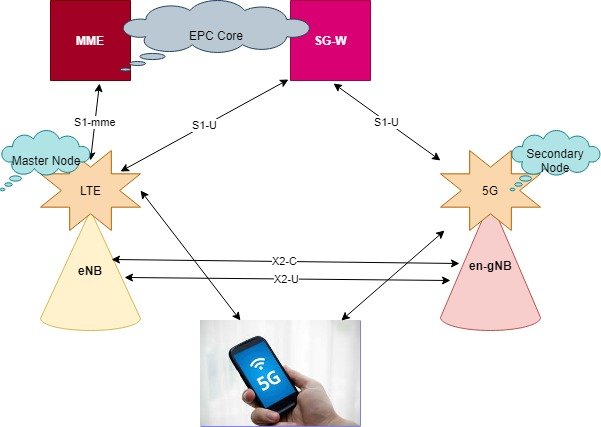
5G NR User and control plane protocol stack architecture
We will discuss Access Network(AN) and Radio Access Network user and control plane protocol in 5G NR. Basically, the user and control plane protocol stack are almost same as in LTE. SDAP is the only new layer introduced in 5G. So, if you know lte, then it will be easy for you to understand. Functions are also same with some added features. The figure clearly explains the user plane and control plane protocols. The user plane protocols are PHY, MAC, RLC, PDC and SDAP and the control plane protocols are PHY, MAC, RLC, PDC, RRC and NSA. Let’s see their main functions now.
User And Control Plane Protocol Functions in 5G NR
NAS (Non Access Stratum) control protocol
NAS is a Control plane protocol. The main services and functions of NAS are:
- The NAS is a control protocol which terminates in AMF on the network side.
- The Access Network transports NAS “transparently”. This means eNB transfers NAS messages without interpretation.
- The main functions of NAS are authentication, mobility management and security control.
- For more info, you can read spec TS 23.501.
RRC (Radio Resource Control)
RRC is the control plane protocol and it’s main services and functions are:
- Broadcast of System Information related to AS and NAS.
- Paging initiated by 5GC or NG RAN.
- Establishment, maintenance and release of an RRC connection between the UE and NG RAN.
- Addition, modification and release of carrier aggregation.
- Addition, modification and release of Dual Connectivity in NR or between E UTRA and NR.
- Security functions including key management.
- Establishment, configuration, maintenance and release of Signalling Radio Bearers (SRBs) and Data Radio Bearers (DRBs).
- Mobility functions like Handover and context transfer.
- UE cell selection and reselection and control of cell selection and reselection.
- Inter RAT mobility.
- QoS management functions.
- UE measurement reporting and control of the reporting.
- Detection of and recovery from radio link failure.
- NAS message transfer to AMF from UE.
- NAS message transfer to UE from AMF.
SDAP (Service Data Adaptation Protocol)
This is a user plane protocol only. This was introduced in 5G NR due to new quality of service handling. The main services and functions of SDAP are:
- Mapping between a QoS flow bearers to data radio bearer according to their quality of service requirements.
- Marking QoS flow ID (QFI) in both DL and UL packets.
PDCP (Packet Data Convergence Protocol)
User plane functions of PDCP sub layer:
- Sequence Numbering.
- Header compression and decompression (ROHC).
- Transfer of user data to lower layer.
- Reordering and duplicate detection.
- PDCP PDU routing in case of split bearers.
- Re transmission of PDCP SDUs.
- Ciphering, deciphering.
- PDCP SDU discard if duplication detected.
- PDCP re establishment and data recovery for RLC AM.
Control plane functions of PDCP sub layer:
- Sequence Numbering.
- Ciphering, deciphering and integrity protection.
- Transfer of control plane data to lower layer.
- Reordering and duplicate detection.
- Duplication of PDCP PDUs.
RLC (Radio Link Control)
The main services and functions of the RLC sub layer are:
- Transfer of upper layer PDUs to MAC through logical channels.
- Sequence numbering independent of the one in PDCP (only for Unacknowledged Mode (UM) and Acknowledged Mode (AM)).
- Error Correction through ARQ (AM only).
- Segmentation (AM and UM) of RLC SDUs.
- Re segmentation (AM only) of RLC SDUs.
- Reassembly of SDU (AM and UM).
- Duplicate Detection (AM only) of PDUs.
- RLC SDU discard (AM and UM).
- RLC re establishment.
- Protocol error detection (AM only).
MAC (Medium Access Control)
The main services and functions of MAC are:
- Mapping between logical channels and transport channels.
- Multiplexing of MAC SDUs belonging to one or different logical channels into transport blocks (TB) and deliver to the physical layer on transport channels.
- Demultiplexing of MAC SDUs from Transport Blocks (TB) delivered from the physical layer on transport channels.
- DL and UL Scheduling information reporting.
- Error correction through Hybrid Automatic Repeat reQuest (HARQ).
- Dynamic scheduling to handle Priority between UEs.
- Priority handling between logical channels of one UE by means of logical channel prioritization.
- Padding.
PHY (Physical Layer)
The main services and functions are:
- The modulation and demodulation of the signal on the radio interface.
- It handles coding and decoding.
- Mapping of multiple antennas.
- CRC bit checking.
- Provides services to MAC layer in the form of transport channel.
- Beam forming.
Source for user and control plane protocol in 5G NR: 3gpp release 15.
Click here for Initial Access and cell selection call flows in 5G NR Network.
Please join our 5G forum and share your knowledge. We can share our NR problems that we face everyday and help each other. There are thousand of other experts are there to help you.



